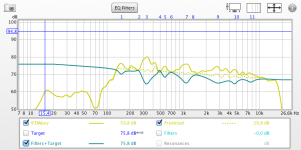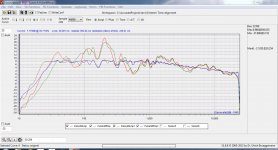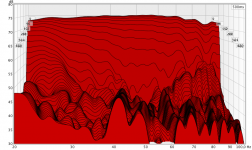Hi guys,
With the availability of cheap and good quality parametric EQs I was wondering if they can be used for room/speaker correction.
I'd like to hear everybody's thoughts on the topic. How can PEQs improve reproduction? Can we improve only a single point or even multiple points? What measurements need to be taken? How do we correlate them to what we hear? How to apply PEQs to mixed-phase responses? Etc. pp.
@Mods: Hope this topic can stay in "Multi-Way" because of visibility and its close relationship to the speaker/room interface.
With the availability of cheap and good quality parametric EQs I was wondering if they can be used for room/speaker correction.
I'd like to hear everybody's thoughts on the topic. How can PEQs improve reproduction? Can we improve only a single point or even multiple points? What measurements need to be taken? How do we correlate them to what we hear? How to apply PEQs to mixed-phase responses? Etc. pp.
@Mods: Hope this topic can stay in "Multi-Way" because of visibility and its close relationship to the speaker/room interface.
Some interesting documentation on the subject:
using IIR biquads, minimum-phase: Transfer function modeling and equalization by fixed-pole parallel filters
using FIR convolution, arbitrary phase: DRC: Digital Room Correction
PORC implements Bank's minimum-phase method using FIR convolution.
Jlo's Align2 combines both approaches and allows for multiple measurements averaging as well.
using IIR biquads, minimum-phase: Transfer function modeling and equalization by fixed-pole parallel filters
using FIR convolution, arbitrary phase: DRC: Digital Room Correction
PORC implements Bank's minimum-phase method using FIR convolution.
Jlo's Align2 combines both approaches and allows for multiple measurements averaging as well.
Last edited:
Some interesting documentation on the subject:
using IIR biquads, minimum-phase: Transfer function modeling and equalization by fixed-pole parallel filters
Thanks. REW does similar:
Attachments
It's a bit broad. What sort of cheap, quality PEQ are you referring to? MiniDSP? Used analog units? You can average a ton of in-room measurements and apply broad, gentle corrections. You can take sets of psuedo-anechoic speaker measurements at different angles to figure out effective speaker correction filters. You can do both.
How can PEQs improve reproduction? Can we improve only a single point or even multiple points? What measurements need to be taken? How do we correlate them to what we hear? How to apply PEQs to mixed-phase responses?
Enormous improvement! I have tried software PEQ in JRiver and hardware PEQ in Yamaha RXV 2067 and Behringer DCX2469. Nasty low frequency peaks from room modes are easily tamed, also loudspeaker frequency response can be smoothed to the perfection, resulting in very neutral and accurate sound.
Resulting frequency response should be flat to about 1-2 kHz and than slowly down to about -8 dB at 20 kHz. Subjectively that is the most neutral sound.
Multiple point improvement depends heavily on the room acoustics - it can be easy, difficult or impossible. Two subwoofers can help though.
You need some frequency measurement system (ARTA, CLIO or something else) and resolution better than 1/3 octave. RTA (real time analyser) with 1/3 octave resolution is to coarse for room modes.
Please clarify the "mixed-phase response" question, I am not sure what it means.
Agree with Sonce, enormous improvement. Also agree with the target fr. I have used PEQ, DRC that pos linked to and many others.
The best I have found is Acourate, which is not free, but under $400 and well worth it in my experience. With Acourate one can Digital XO, time align, and linearize each driver, plus room correction the fr and excess phase.
I wrote an article about my experience with Acourate: Advanced Acourate Digital XO Time Alignment Driver Linearization Walkthrough.
The linear phase FIR filters produced by Acourate are 64 bit (with 65536 taps) and JRiver's Convolution engine hosts them no problem with the benefit of taking into the account the latency produced by the filter so one can still watch movies with no lip sync issues.
One unique aspect of Acourate is it's measurement analysis uses a proprietary frequency dependent windowing (FDW) algorithm. Having used several acoustical analysis software packages over the years, to my ears, Acourate represents best what I see on the charts compared to what I perceive with my ears. The FDW is long at low frequencies (100’s of milliseconds) and short at high frequencies (< a millisecond).
I have listened to minphase, mixedphase, and linphase FIR filters, and linear phase sounds the best to my ears from an imaging perspective. Subjectively, I would agree with Ackchengs description on his site (3rd paragraph).
Hope that helps. Cheers, Mitch
The best I have found is Acourate, which is not free, but under $400 and well worth it in my experience. With Acourate one can Digital XO, time align, and linearize each driver, plus room correction the fr and excess phase.
I wrote an article about my experience with Acourate: Advanced Acourate Digital XO Time Alignment Driver Linearization Walkthrough.
The linear phase FIR filters produced by Acourate are 64 bit (with 65536 taps) and JRiver's Convolution engine hosts them no problem with the benefit of taking into the account the latency produced by the filter so one can still watch movies with no lip sync issues.
One unique aspect of Acourate is it's measurement analysis uses a proprietary frequency dependent windowing (FDW) algorithm. Having used several acoustical analysis software packages over the years, to my ears, Acourate represents best what I see on the charts compared to what I perceive with my ears. The FDW is long at low frequencies (100’s of milliseconds) and short at high frequencies (< a millisecond).
I have listened to minphase, mixedphase, and linphase FIR filters, and linear phase sounds the best to my ears from an imaging perspective. Subjectively, I would agree with Ackchengs description on his site (3rd paragraph).
Hope that helps. Cheers, Mitch
It's a bit broad. What sort of cheap, quality PEQ are you referring to?
No specific model, miniDSP, Behringer, they all provide filters that are minimum-phase, right?
Please clarify the "mixed-phase response" question, I am not sure what it means.
Here's a good read: http://www.dirac.se/media/12044/on_room_correction.pdf
Acourate
Yes, great tool. I have it too.
Just a comment on the single points vs. many points...
LF EQ is very useful and will improve the bass smoothness of a system in a room. Many EQ systems let you average a few (or many) positions in the room. There is a tradeoff involved in that a broad area average will correct the average but will not exactly correct any particular position. Variation of the response between seating locations will always remain the same and can not be improved by simple EQ and a single subwoofer.
If you know your listening position will be fixed, then the most exact EQ is to measure and correct that spot only.
If you want a good result for a number of seats (say across the width of a couch) then measure points across the couch, average the results , and correct the average. This will give generally good results for all seats but not as good as the single positions, single measurement approach. You will have to figure out your own compromise based on what you are looking for.
This is all for low frequencies. For high frequencies results are mixed and we can get into trouble by measuring and correcting a steady state curve. Most practitioners get around that by coming up with some sort of falling EQ target ("house curve"), but this is an inexact science.
David
LF EQ is very useful and will improve the bass smoothness of a system in a room. Many EQ systems let you average a few (or many) positions in the room. There is a tradeoff involved in that a broad area average will correct the average but will not exactly correct any particular position. Variation of the response between seating locations will always remain the same and can not be improved by simple EQ and a single subwoofer.
If you know your listening position will be fixed, then the most exact EQ is to measure and correct that spot only.
If you want a good result for a number of seats (say across the width of a couch) then measure points across the couch, average the results , and correct the average. This will give generally good results for all seats but not as good as the single positions, single measurement approach. You will have to figure out your own compromise based on what you are looking for.
This is all for low frequencies. For high frequencies results are mixed and we can get into trouble by measuring and correcting a steady state curve. Most practitioners get around that by coming up with some sort of falling EQ target ("house curve"), but this is an inexact science.
David
I was taught in the Don Davis Audio Engineering Seminar (many moons ago - but I think it's still true), that EQ is useful for pulling down resonant peaks, but not for pumping up cancellations. If you try to pull up a cancellation in one location, you create a peak in another location, and carried to an extreme you could even cause a driver to be over driven and blow out.
Others have somewhat convinced me that high resolution EQ should only be done below about 300HZ, depending on room size. Gradual rolloffs or rollups from conventional tone controls are a different thing. The only rule there is when it sounds good it is good.
In a typical living room of a typical house, it's about when half wavelengths fit inside the room boundaries. Above 300HZ (very roughly), many rooms will have many reflection paths filling in the cancellations of other reflection comb filter effects at any given location. Below 300HZ, due to the size of the wavelengths, there may only be a few paths of reflection that can fill in cancellations anywhere in the room. So EQing above 300HZ is more likely to create spatial inconsistencies, and EQing below 300HZ has a good chance of making significant improvement.
I've had no trouble at all using active EQ to pump up the very low end, below 80HZ (down to 20 or 30HZ), but between 80HZ and 200HZ I've noticed that many rooms will cause substantial possibly resonant peaks, and dips (cancellations), creating boomy sounding bass and lower mid. This is the so-called "Shroeder frequency" area. Pulling down peaks in this area may be one of the best things you can do with a system, once you've exhausted any possibilities of speaker placement variables.
Linkwitz tries to minimize room acoustics problems in the lower mid and bass frequencies by creating a relatively directional acoustic output, using the dipole approach. That can work, but when I listened to his Orion speakers the lower mid and bass seemed pretty rolled off and low bass was gone. I personally believe in the opposite approach of illuminating the room on all 3 axis with lower-mid and bass, by using woofer towers on each side, and a vertical array of lower mid drivers as well. It depends so much on the room it's hard to say what is best. That's my 2 cents anyway.
Others have somewhat convinced me that high resolution EQ should only be done below about 300HZ, depending on room size. Gradual rolloffs or rollups from conventional tone controls are a different thing. The only rule there is when it sounds good it is good.
In a typical living room of a typical house, it's about when half wavelengths fit inside the room boundaries. Above 300HZ (very roughly), many rooms will have many reflection paths filling in the cancellations of other reflection comb filter effects at any given location. Below 300HZ, due to the size of the wavelengths, there may only be a few paths of reflection that can fill in cancellations anywhere in the room. So EQing above 300HZ is more likely to create spatial inconsistencies, and EQing below 300HZ has a good chance of making significant improvement.
I've had no trouble at all using active EQ to pump up the very low end, below 80HZ (down to 20 or 30HZ), but between 80HZ and 200HZ I've noticed that many rooms will cause substantial possibly resonant peaks, and dips (cancellations), creating boomy sounding bass and lower mid. This is the so-called "Shroeder frequency" area. Pulling down peaks in this area may be one of the best things you can do with a system, once you've exhausted any possibilities of speaker placement variables.
Linkwitz tries to minimize room acoustics problems in the lower mid and bass frequencies by creating a relatively directional acoustic output, using the dipole approach. That can work, but when I listened to his Orion speakers the lower mid and bass seemed pretty rolled off and low bass was gone. I personally believe in the opposite approach of illuminating the room on all 3 axis with lower-mid and bass, by using woofer towers on each side, and a vertical array of lower mid drivers as well. It depends so much on the room it's hard to say what is best. That's my 2 cents anyway.
how do you avoid affecting speaker driver's crossover functions (slopes)?
The signal going to the speaker is equalized hence the crossover inside the speaker isn't affected at all.
The signal going to the speaker is equalized hence the crossover inside the speaker isn't affected at all.
really ? ... are you 100% sure about that ?
I mean, the crossovers have been constructed with the expectation of a smooth response
and now you feed them with a much altered response ?
even just attenuating a single driver in a multiway active speaker can cause small crossover changes
to work 100% properly I think you have to start from the ground up, and design everything 'in room' ... the whole lot
I'm sure some of the pro guys know this stuff very well
the crossovers have been constructed with the expectation of a smooth response
and now you feed them with a much altered response ?
Music is a "much altered response" and it doesn't change the crossover so I don't understand your comment.
Here is a quick example of Acourate digital room correction of the before and after at the listening position of my old school Cornwall type clones with CD horns. The after is +- 2dB from 32 Hz to 1 kHz and +-1 to 1/2dB from 1 kHz to beyond 20 kHz within the target response.
Finite Impulse Response (FIR) filters provide corrections both in the frequency and time domain (excess phase). And at 65,536 filter tap length and 64 bit processing on a computer offers a level of performance/resolution that most people may not have heard before... regardless of listening position. It is a real ear opener.
PS. If you go the full nine yards with Acourate's digital XO, time align the drivers, linearize each individual driver, and then apply room correction, one will be rewarded with the smoothest frequency response, excellent step response, and imaging that really makes the speakers disappear.
Finite Impulse Response (FIR) filters provide corrections both in the frequency and time domain (excess phase). And at 65,536 filter tap length and 64 bit processing on a computer offers a level of performance/resolution that most people may not have heard before... regardless of listening position. It is a real ear opener.
PS. If you go the full nine yards with Acourate's digital XO, time align the drivers, linearize each individual driver, and then apply room correction, one will be rewarded with the smoothest frequency response, excellent step response, and imaging that really makes the speakers disappear.
Attachments
Hi,
Delayed bass sinks - this is somewhat different approach to room EQ.
http://vbn.aau.dk/files/62729248/LF_sound_field_control.pdf
Bodzio Software
Best Regards,
Bohdan
Delayed bass sinks - this is somewhat different approach to room EQ.
http://vbn.aau.dk/files/62729248/LF_sound_field_control.pdf
Bodzio Software
Best Regards,
Bohdan
Hi,
Delayed bass sinks - this is somewhat different approach to room EQ.
http://vbn.aau.dk/files/62729248/LF_sound_field_control.pdf
Bodzio Software
Best Regards,
Bohdan
Yes, CABS or DBA can deliver great results. Here's another example: Double Bass Array (DBA) - The modern bass concept!
I've also had great results with direct field listening by placing subs very close to the ear (about 1 ft.):
(The stuff <45Hz is mostly noise floor only)
Those approaches work great at subwoofer frequencies, i.e. below <80Hz but how can we improve higher frequencies with PEQ or EQ in general?
Attachments
- Status
- This old topic is closed. If you want to reopen this topic, contact a moderator using the "Report Post" button.
- Home
- General Interest
- Room Acoustics & Mods
- Room Correction with PEQ


